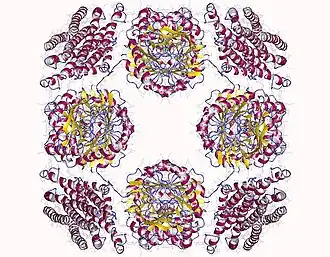Formimidoyltransferase cyclodeaminase
| formimidoyltransferase cyclodeaminase | |||||||
|---|---|---|---|---|---|---|---|
 Formiminotransferase cyclodeaminase homooctamer, Rattus norvegicus | |||||||
| Identifiers | |||||||
| Symbol | FTCD | ||||||
| Alt. names | formiminotransferase cyclodeaminase | ||||||
| NCBI gene | 10841 | ||||||
| HGNC | 3974 | ||||||
| OMIM | 606806 | ||||||
| RefSeq | NM_006657 | ||||||
| UniProt | O95954 | ||||||
| Other data | |||||||
| Locus | Chr. 21 q22.3 | ||||||
| |||||||
Formimidoyltransferase cyclodeaminase or formiminotransferase cyclodeaminase (gene symbol FTCD in humans) is a bifunctional enzyme that catalyzes the following reactions:[1]
- conversion of formiminoglutamate and tetrahydrofolate into formiminotetrahydrofolate and glutamate (glutamate formimidoyltransferase activity, EC 2.1.2.5)
- subsequent deamination of formiminotetrahydrofolate to 5,10-methenyltetrahydrofolate and ammonia (formimidoyltetrahydrofolate cyclodeaminase activity, EC 4.3.1.4)
Its name comes from the two activities it catalyzes.
Role in pathology
Mutations of the FTCD gene cause glutamate formiminotransferase deficiency.[1]
See also
References
- ^ a b "Glutamate formiminotransferase deficiency". NIH. GARD. August 10, 2016. Archived from the original on December 29, 2016. Retrieved December 21, 2020.